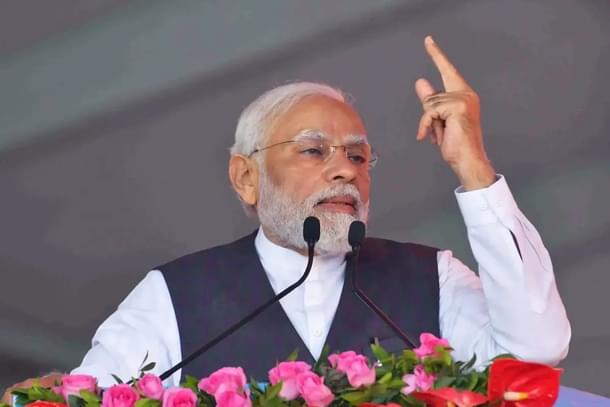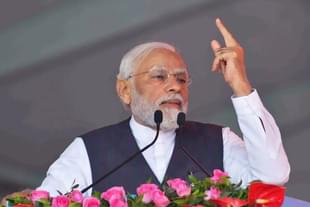Politics
'400 Paar' Or 'Third-Largest GDP': These Objective Targets Needed Emotional Hooks
Arush Tandon
Jul 28, 2024, 11:33 AM | Updated Dec 27, 2024, 02:42 PM IST
Save & read from anywhere!
Bookmark stories for easy access on any device or the Swarajya app.


How much of an economic inconvenience are you willing to suffer as a cost of buying into the ‘story’ of a leader?
Here, 'leader' refers to Narendra Modi, and 'story' refers to the macro, sweeping narrative accompanying him.
When Narendra Modi became the Prime Minister in 2014, his 'story' was this: The UPA regime was a corrupt, inept, inactive government kept together solely by the antipathy its constituents shared towards the Hindu culture of India.
India needed a force to not only dislodge this regime but also become the antithesis of the UPA — an efficient, clean administration that was proud of India’s heritage and actively worked to protect and promote it. This force was Modi.
He would not only pull India to a better position materially, he would do it as a proud Hindu. This was his story. With his first speech in the Central Hall of Parliament and his subsequent tenure, he added another narrative to this — the Modi government would always prioritise the poor.
A well-rounded, culturally-rooted, emotionally appealing ‘story.’
It was the result of the buying into this ‘story’ that when Modi asked the better-off to voluntarily give up their subsidised LPG connections, more than 1 crore Indians obliged without thinking twice.
It was the result of buying into this story that when he implemented the most disruptive and most widely impactful executive decision of independent India — demonetisation (DeMo) — at that time, except for stray incidents, there was no large-scale protest against it anywhere. On the contrary, five months later, the BJP won its largest mandate ever in Uttar Pradesh in a campaign led solely by Modi.
Make no mistake, DeMo brought unprecedented disruption to the lives of crores of Indians but they went with it because there was a larger ‘story’ to it and the man.
Now come to the present day.
Assume for a moment that PM Modi addresses the nation later tonight and declares that all currency notes of 500 denomination will be demonetised at midnight. It’s a safe guess that not only would there be large-scale protests, they could even snowball into acts of violence.
What changed between November 2016 and this hypothetical scenario today? It’s the same Modi, with the same un-corruptible, indefatigable image.
What changed, in this writer’s view, is the larger ‘story.’
In 2016, the masses bought into demonetisation because any inconvenience could be explained and rationalised as an act against black money hoarding. It was seen as a step towards making India a better place. Their contemporary suffering held a larger, noble meaning and objective.
Today, you cannot ascribe the same meaning to demonetisation because the accompanying ‘story’ has weakened. Even if black money in the economy has reduced, corruption persists unabated at many avenues of the government-public interface, especially at the state level.
In 2016, people understood that Modi had only been in power for two years. Today, a decade later, if a municipal official is demanding the same bribe as in 2016, then even if the municipality isn't Modi’s direct responsibility, people will be far less enthused about any anti-corruption drive by the prime minister or his party.
The signals were actually there in February. In the last days of the previous Lok Sabha, many speakers from the treasury benches focussed their speeches on how the third term of Modi would take the Indian economy to the position of the third-largest GDP. A vital, necessary objective.
But what was the emotional hook in this message for a homemaker in, say, Shravasti? She voted for Modi in 2014 and 2019. She received a house in her name under Awas Yojana, an LPG connection through Ujjwala Yojana, and health insurance under Ayushmaan Bharat.
In 2024, she wasn’t averse to Modi, but no one explained to her how India becoming the third-largest GDP would benefit her directly, nor did anyone translate that statistical goal into an emotional aspiration.
In the absence of a national 'story,' she voted for the local narrative playing out inside her home and outside on the lanes.
Same for ‘400 paar.’ If the BJP got more than 400 seats in the Lok Sabha, how would her life improve over and above what Modi had already managed to do between 2014 and 2024?
At this point, a reader cannot be faulted for asking, "Well then, what about Gujarat, Madhya Pradesh, and Odisha? Or the fact that BJP still won 240 seats in the Lok Sabha?"
The answer is: In Gujarat and MP, a critical mass of voters, plus some more, has over the years turned into core BJP supporters. Odisha had reasons specific to it alone for choosing the BJP over the BJD.
And in any case, we are not discussing BJP losing support in this piece. The point of this piece is that even those who voted for the BJP may have moved on from the 'story' accompanying Modi.
Human nature can endure suffering if seen as part of a larger divine/cosmic plan. If there is a ‘story’ to it. But if you are told that your adversities and ordeals have no meaning beyond causing agony to you, almost all people would break down.
It’s rather the same at a societal level too. People will ignore statistics as long as they are buying into the leader emotionally.
Stories are important. They give meaning to experiences. Otherwise, we are all simply stacks of atoms strutting around on a giant rock.





